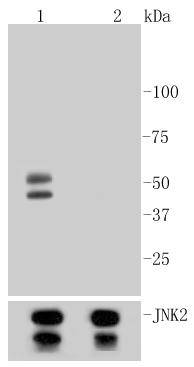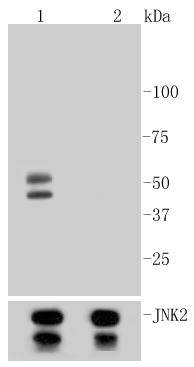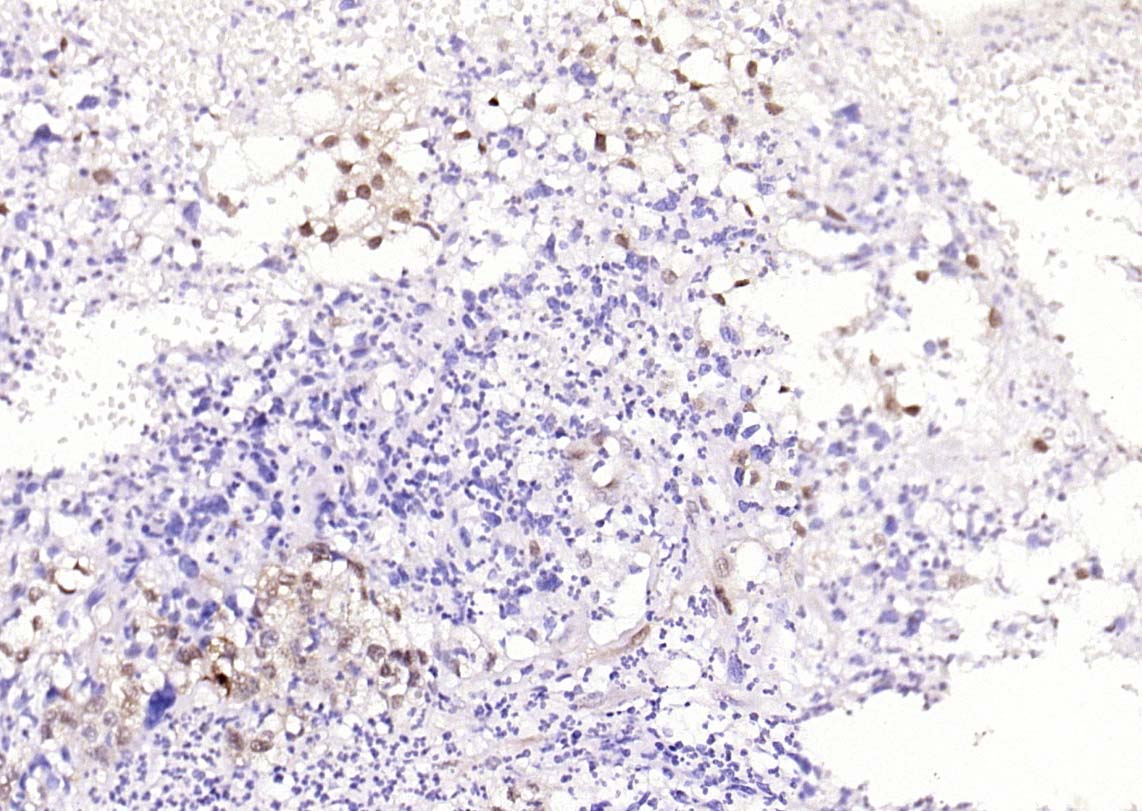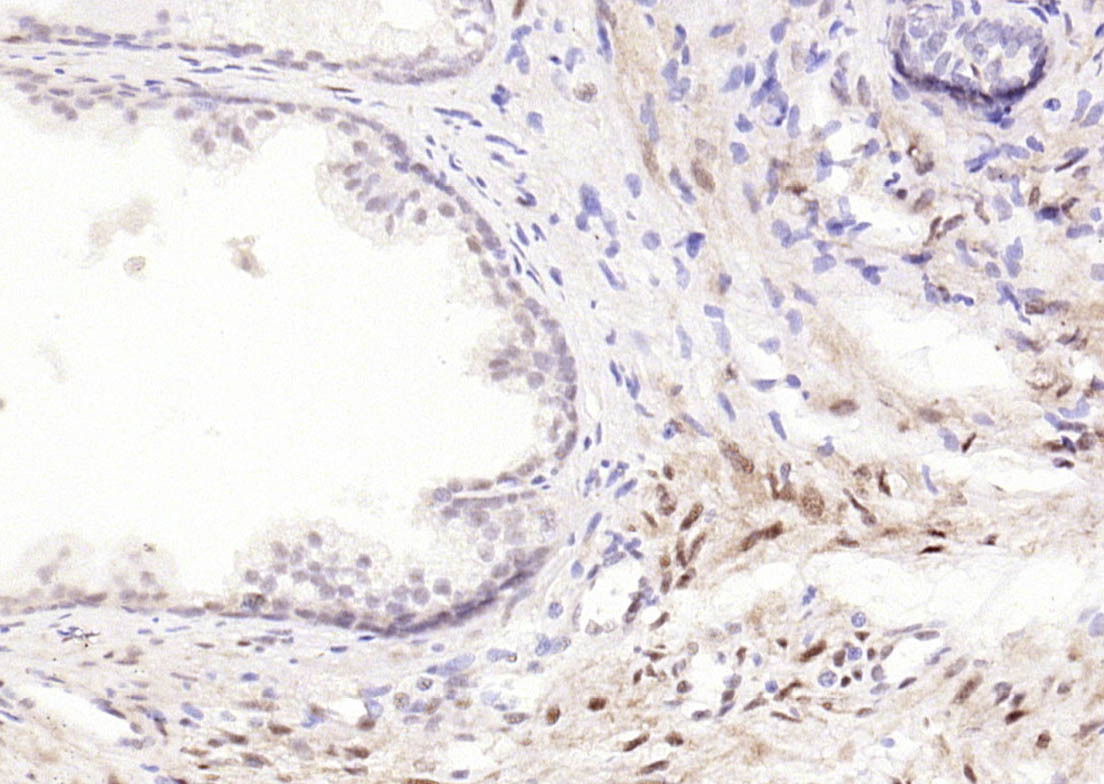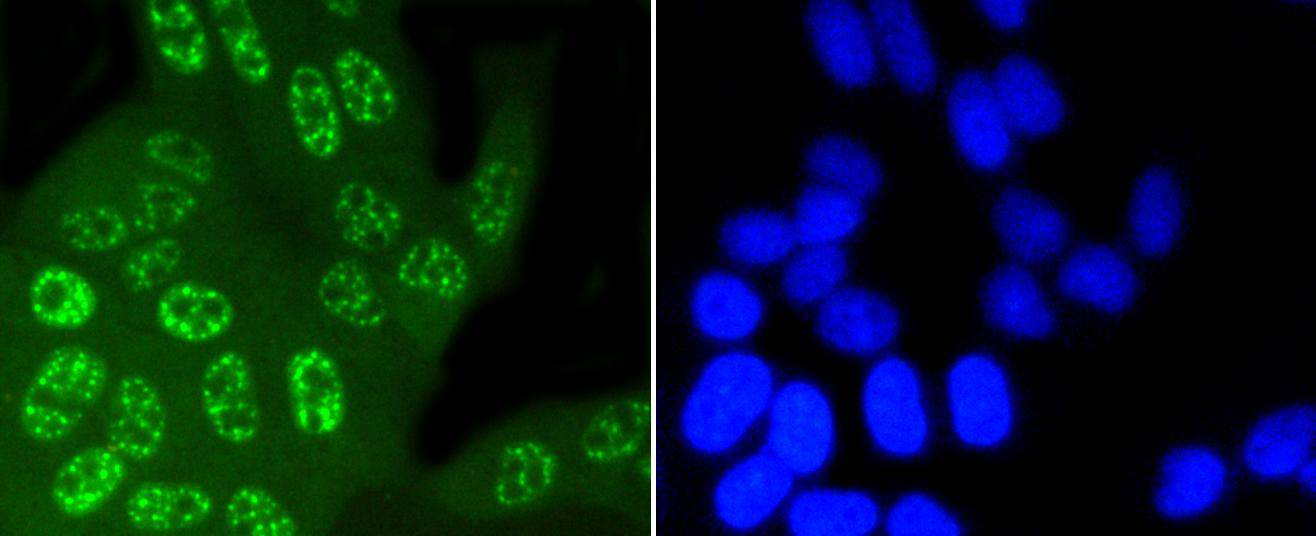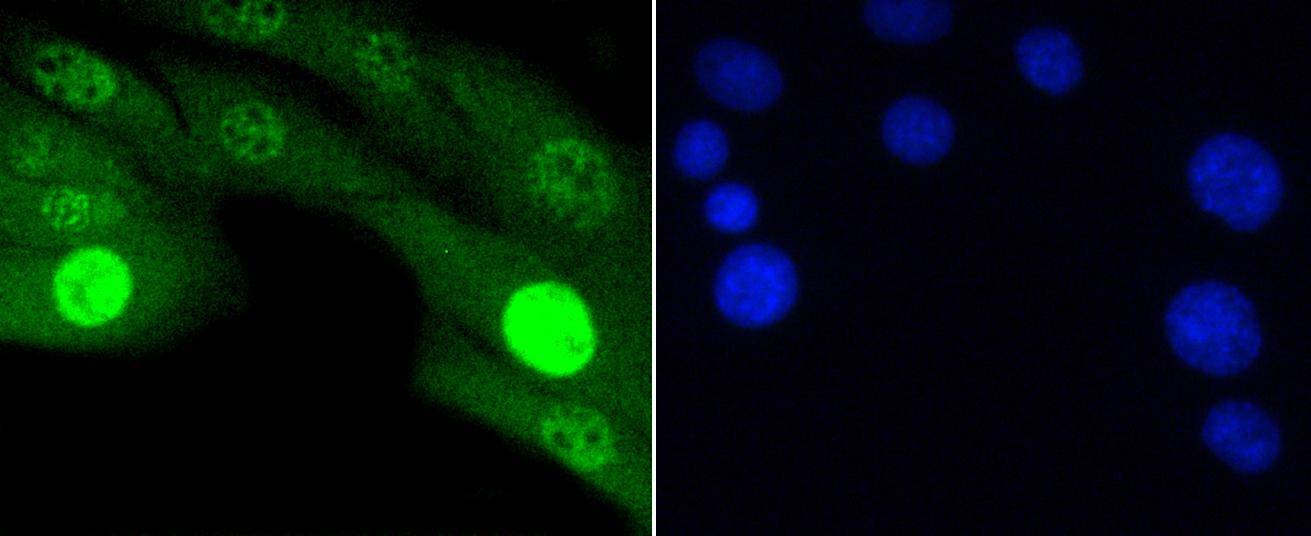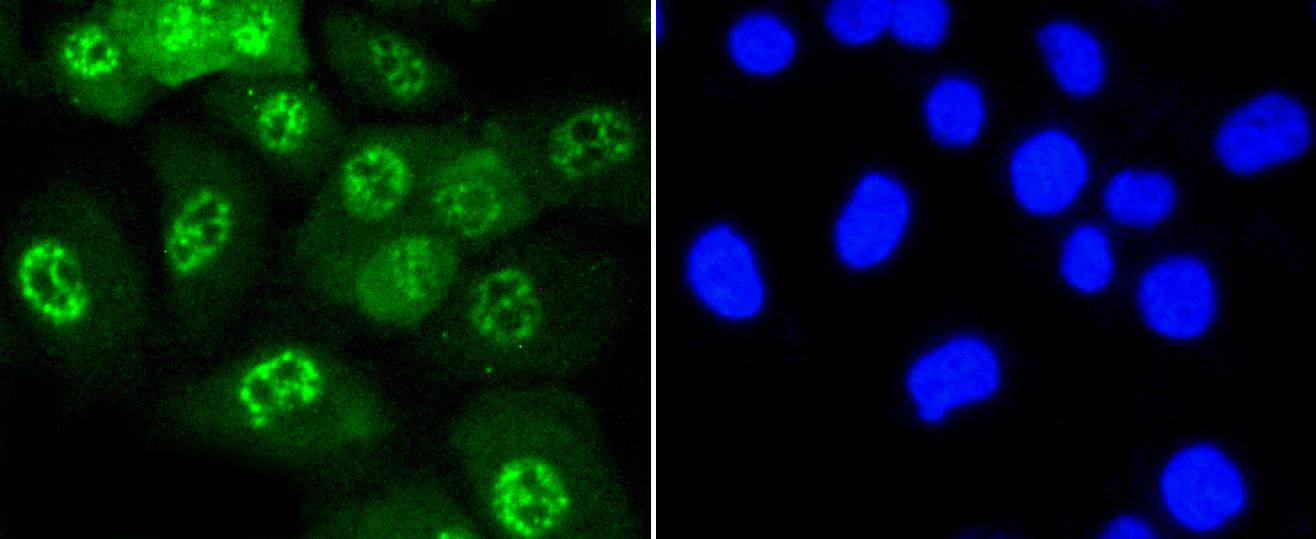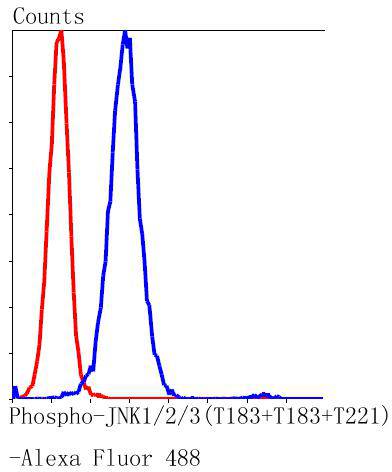| 產品編號 | bsm-52462R |
| 英文名稱 | Rabbit Anti-Phospho-JNK1/2/3(T183+T183+T221) antibody |
| 中文名稱 | 磷酸化氨基末端激酶1/2/3重組兔單抗 |
| 別 名 | JNK1 + JNK2 + JNK3 (phospho T183 + T183 + T221); JNK1 (phospho T183); p-JNK1 (phospho T183); MAPK8 (phospho T183); JNK1 + JNK2 (phospho Thr183 + Thr183); JNK1 + 2 (phospho Thr183+Thr183); p-JNK; c Jun N terminal kinase 1; C-JUN kinase 1; EC 2.7.11.24; JAK 1A; JAK1A; JNK 1; JNK 46; JNK; JNK1A2; JNK21B1/2; MAP kinase 8; MAPK 8; MAPK8; Mitogen activated protein kinase 8; p54 gamma; PRKM 8; PRKM8; Protein kinase JNK1; Protein kinase, mitogen-activated, 8; SAPK 1; SAPK gamma; SAPK1; Stress activated protein kinase JNK1; Stress-activated protein kinase JNK1; Tyrosine protein kinase JAK1; AI849689; MK08_HUMAN; MK09_HUMAN; MK10_HUMAN. |
 | Specific References (2) | bsm-52462R has been referenced in 2 publications. [IF=8.025] Ying-Xue Liu. et al. Reactive oxygen species–mediated phosphorylation of JNK is involved in the regulation of BmFerHCH on Bombyx mori nucleopolyhedrovirus proliferation. INT J BIOL MACROMOL. 2023 Apr;235:123834 IF,WB ; Silkworm. [IF=2.447] Mei-Hua Jin. et al. Hispidin inhibits LPS?induced nitric oxide production in BV?2 microglial cells via ROS?dependent MAPK signaling. Exp Ther Med. 2021 Sep;22(3):1-9 WB ; Mouse. |
| 研究領域 | 腫瘤 信號轉導 轉錄調節因子 |
| 抗體來源 | Rabbit |
| 克隆類型 | Recombinant |
| 克 隆 號 | 6C10 |
| 交叉反應 | Rat,Mouse,Human |
| 產品應用 | WB=1:200-1000, IHC-P=1:20-100, IHC-F=1:20-100, ICC=1:20-50, Flow-Cyt=1:20-100 not yet tested in other applications. optimal dilutions/concentrations should be determined by the end user. |
| 理論分子量 | 42kDa |
| 細胞定位 | 細胞核 細胞漿 |
| 性 狀 | Liquid |
| 濃 度 | 1mg/ml |
| 免 疫 原 | KLH conjugated Synthesised phosphopeptide derived from human JNK1/JNK2/JNK3 around the phosphorylation site of T183/T183/T221: MM(p-T)PY |
| 亞 型 | IgG |
| 純化方法 | affinity purified by Protein A |
| 緩 沖 液 | 0.01M TBS(pH7.4) with 1% BSA, 0.03% Proclin300 and 50% Glycerol. |
| 保存條件 | Shipped at 4℃. Store at -20 °C for one year. Avoid repeated freeze/thaw cycles. |
| 注意事項 | This product as supplied is intended for research use only, not for use in human, therapeutic or diagnostic applications. |
| PubMed | PubMed |
| 產品介紹 | The protein encoded by this gene is a member of the MAP kinase family. MAP kinases act as an integration point for multiple biochemical signals, and are involved in a wide variety of cellular processes such as proliferation, differentiation, transcription regulation and development. This kinase is activated by various cell stimuli, and targets specific transcription factors, and thus mediates immediate-early gene expression in response to cell stimuli. The activation of this kinase by tumor-necrosis factor alpha (TNF-alpha) is found to be required for TNF-alpha induced apoptosis. This kinase is also involved in UV radiation induced apoptosis, which is thought to be related to cytochrom c-mediated cell death pathway. Studies of the mouse counterpart of this gene suggested that this kinase play a key role in T cell proliferation, apoptosis and differentiation. Five alternatively spliced transcript variants encoding distinct isoforms have been reported. [provided by RefSeq, Jun 2013] Function: Serine/threonine-protein kinase involved in various processes such as cell proliferation, differentiation, migration, transformation and programmed cell death. Extracellular stimuli such as proinflammatory cytokines or physical stress stimulate the stress-activated protein kinase/c-Jun N-terminal kinase (SAP/JNK) signaling pathway. In this cascade, two dual specificity kinases MAP2K4/MKK4 and MAP2K7/MKK7 phosphorylate and activate MAPK8/JNK1. In turn, MAPK8/JNK1 phosphorylates a number of transcription factors, primarily components of AP-1 such as JUN, JDP2 and ATF2 and thus regulates AP-1 transcriptional activity. Phosphorylates the replication licensing factor CDT1, inhibiting the interaction between CDT1 and the histone H4 acetylase HBO1 to replication origins. Loss of this interaction abrogates the acetylation required for replication initiation. Promotes stressed cell apoptosis by phosphorylating key regulatory factors including p53/TP53 and Yes-associates protein YAP1. In T-cells, MAPK8 and MAPK9 are required for polarized differentiation of T-helper cells into Th1 cells. Contributes to the survival of erythroid cells by phosphorylating the antagonist of cell death BAD upon EPO stimulation. Mediates starvation-induced BCL2 phosphorylation, BCL2 dissociation from BECN1, and thus activation of autophagy. Phosphorylates STMN2 and hence regulates microtubule dynamics, controlling neurite elongation in cortical neurons. In the developing brain, through its cytoplasmic activity on STMN2, negatively regulates the rate of exit from multipolar stage and of radial migration from the ventricular zone. Phosphorylates several other substrates including heat shock factor protein 4 (HSF4), the deacetylase SIRT1, ELK1, or the E3 ligase ITCH. JNK1 isoforms display different binding patterns: beta-1 preferentially binds to c-Jun, whereas alpha-1, alpha-2, and beta-2 have a similar low level of binding to both c-Jun or ATF2. However, there is no correlation between binding and phosphorylation, which is achieved at about the same efficiency by all isoforms. Subcellular Location: Cytoplasm. Nucleus. Post-translational modifications: Dually phosphorylated on Thr-183 and Tyr-185 by MAP2K7 and MAP2K4, which activates the enzyme. Phosphorylated by TAOK2. Similarity: Belongs to the protein kinase superfamily. CMGC Ser/Thr protein kinase family. MAP kinase subfamily. Contains 1 protein kinase domain. SWISS: P45983 Gene ID: 5599 Database links: Entrez Gene: 5599 Human Entrez Gene: 5601 Human Entrez Gene: 5602 Human Entrez Gene: 26414 Mouse Entrez Gene: 26419 Mouse Entrez Gene: 26420 Mouse Omim: 601158 Human Omim: 602896 Human Omim: 602897 Human SwissProt: P45983 Human SwissProt: P45984 Human SwissProt: P53779 Human SwissProt: Q61831 Mouse SwissProt: Q91Y86 Mouse SwissProt: Q9WTU6 Mouse Unigene: 138211 Human Unigene: 522924 Human Unigene: 21495 Mouse Unigene: 4090 Rat |
| 產品圖片 | Sample: Lane 1: NIH/3T3 cell lysate, treated with Anisomycin Lane 2: NIH/3T3 cell lysate, untreated Primary: Anti-Phospho-JNK1/2/3(T183+T183+T221) (bsm-52462R) at 1:500 dilution Secondary: Goat Anti-Rabbit IgG - HRP at 1:5000 dilution Predicted band size: 42 kD Observed band size: 54/46 kD Paraformaldehyde-fixed, paraffin embedded (human Uterine Corpus Cancer); Antigen retrieval by boiling in sodium citrate buffer (pH6.0) for 15min; Block endogenous peroxidase by 3% hydrogen peroxide for 20 minutes; Blocking buffer (normal goat serum) at 37°C for 30min; Antibody incubation with (Phospho-JNK123(T183+T183+T221)) Monoclonal Antibody, Unconjugated (bsm-52462R) at 1:200 overnight at 4°C, followed by operating according to SP Kit(Rabbit) (sp-0023) instructionsand DAB staining. Paraformaldehyde-fixed, paraffin embedded (human gastric carcinoma); Antigen retrieval by boiling in sodium citrate buffer (pH6.0) for 15min; Block endogenous peroxidase by 3% hydrogen peroxide for 20 minutes; Blocking buffer (normal goat serum) at 37°C for 30min; Antibody incubation with (Phospho-JNK123(T183+T183+T221)) Monoclonal Antibody, Unconjugated (bsm-52462R) at 1:200 overnight at 4°C, followed by operating according to SP Kit(Rabbit) (sp-0023) instructionsand DAB staining. Paraformaldehyde-fixed, paraffin embedded (human prostate); Antigen retrieval by boiling in sodium citrate buffer (pH6.0) for 15min; Block endogenous peroxidase by 3% hydrogen peroxide for 20 minutes; Blocking buffer (normal goat serum) at 37°C for 30min; Antibody incubation with (Phospho-JNK123(T183+T183+T221)) Monoclonal Antibody, Unconjugated (bsm-52462R) at 1:200 overnight at 4°C, followed by operating according to SP Kit(Rabbit) (sp-0023) instructionsand DAB staining. Paraformaldehyde-fixed, paraffin embedded (rat kidney); Antigen retrieval by boiling in sodium citrate buffer (pH6.0) for 15min; Block endogenous peroxidase by 3% hydrogen peroxide for 20 minutes; Blocking buffer (normal goat serum) at 37°C for 30min; Antibody incubation with (Phospho-JNK123(T183+T183+T221)) Monoclonal Antibody, Unconjugated (bsm-52462R) at 1:200 overnight at 4°C, followed by operating according to SP Kit(Rabbit) (sp-0023) instructionsand DAB staining. Hela cell; 4% Paraformaldehyde-fixed; Triton X-100 at room temperature for 20 min; Blocking buffer (normal goat serum,C-0005) at 37°C for 20 min; Antibody incubation with ( Phospho-JNK1/2/3(T183+T183+T221)) monoclonal Antibody, Unconjugated (bsm-52462R) 1:50, 90 minutes at 37°C; followed by a conjugated Goat Anti-Rabbit IgG antibody at 37°C for 90 minutes, DAPI (blue, C02-04002) was used to stain the cell nuclei. NIH/3T3 cell; 4% Paraformaldehyde-fixed; Triton X-100 at room temperature for 20 min; Blocking buffer (normal goat serum,C-0005) at 37°C for 20 min; Antibody incubation with (Phospho-JNK1/2/3(T183+T183+T221)) monoclonal Antibody, Unconjugated (bsm-52462R) 1:50, 90 minutes at 37°C; followed by a conjugated Goat Anti-Rabbit IgG antibody at 37°C for 90 minutes, DAPI (blue, C02-04002) was used to stain the cell nuclei. HUVEC cell; 4% Paraformaldehyde-fixed; Triton X-100 at room temperature for 20 min; Blocking buffer (normal goat serum,C-0005) at 37°C for 20 min; Antibody incubation with ( Phospho-JNK1/2/3(T183+T183+T221)) monoclonal Antibody, Unconjugated (bsm-52462R) 1:50, 90 minutes at 37°C; followed by a conjugated Goat Anti-Rabbit IgG antibody at 37°C for 90 minutes, DAPI (blue, C02-04002) was used to stain the cell nuclei. Blank control:Hela. Primary Antibody (green line): Rabbit Anti-Phospho-JNK1/2/3(T183+T183+T221) antibody (bsm-52462R) Dilution: 1:100; Isotype Control Antibody (orange line): Rabbit IgG . Secondary Antibody : Goat anti-rabbit IgG-AF488 Dilution: 1:1000. Protocol The cells were fixed with 4% PFA (10min at room temperature)and then permeabilized with 90% ice-cold methanol for 20 min at-20℃.The cells were then incubated in 5%BSA to block non-specific protein-protein interactions for 30 min at room temperature .Cells stained with Primary Antibody for 30 min at room temperature. The secondary antibody used for 40 min at room temperature. Acquisition of 20,000 events was performed. |


